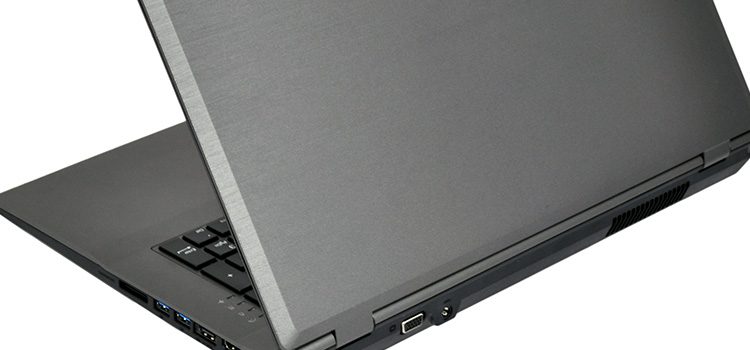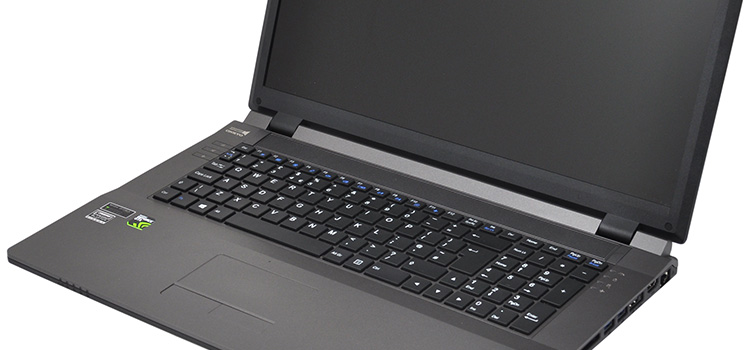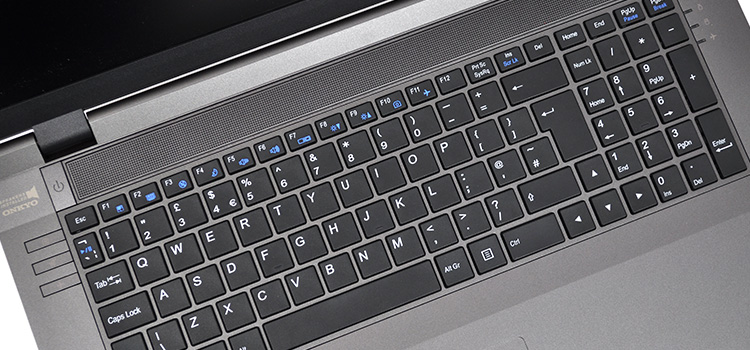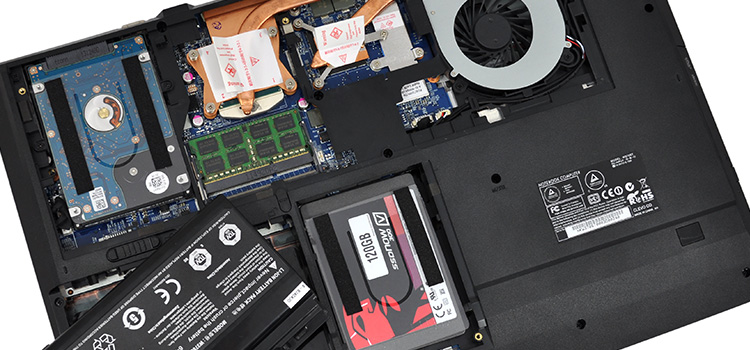Optimus V X17
The SkyFire III has shown that cramming high-end components into a compact frame continues to be problematic. A hot-running CPU and GPU combination really needs room to breathe, so for gamers, a larger laptop should offer all the performance without any of the throttling.
And they don't come much larger than the Optimus V X17, which on paper appears to offer a lot of laptop for the £879 asking fee.
It's important to get a sense of the scale of this thing. If, like us, you've become accustomed to tablets and Ultrabooks in recent years, the Optimus V X17 will look and feel huge. The 17.3in laptop measures 413mm x 277.5mm x 17.5~44mm in size and weighs 3.2kg, which as you can imagine isn't the best combination for portability. You'd need a strong arm or a big bag to carry this one around on a regular basis, but where the system makes a lot of sense is as a desktop replacement.
Fans of barebone solutions should recognise the chassis - it's a Clevo W370ST - and, once again, PC Specialist has kept the design as simple as possible. There's no branding on the exterior, giving the entire laptop a clean, uninterrupted finish, and the grey paintwork plays its part in doing a good job of looking sleek and repelling fingerprints. Plastic is once again the primary material, but aside from the flex in the display, the chassis' sheer size makes it feel reasonably robust.
The almost-entirely grey design can come across as sparse, but open up the lid and you become engulfed with what the laptop has to offer. The full-size keyboard - including numpad - and the large 17.3in display are inviting, and during use, it's easy to forget you're on a laptop.
Aiming to replicate almost everything you'd find on a desktop, the Optimus V X17 includes all the ports and connectivity options you'd expect to have on a device of this size. Along the left edge, the chassis houses a Blu-ray reader, three audio jacks and a USB 2.0 port. On the right side you'll find Gigabit Ethernet, HDMI out, eSATA/USB 3.0, two further USB 3.0 ports and a multi-card reader. The connector for the bundled power brick and VGA output, meanwhile, are tucked neatly around the back, and both Wireless N and Bluetooth connectivity are of course included as standard.
The corner stone of any 17in laptop is a large, enjoyable display, and the Optimus V X17 has exactly that. The matte TN panel sports a full-HD, 1,920x1,080 resolution and, though it isn't quite as eye-catching as some of the IPS solutions now on the market, this is one of the better TN panels available. Viewing angles are reasonable, colour reproduction is good and the display is plenty bright.
The one real limitation - and this also applies to the SkyFire III - is that the display isn't touchscreen. The more time we spend with Windows 8 on a laptop, the more we've come to realise that a touchscreen panel really ought to be included as standard.
Elsewhere, while watching movies and playing full-HD games is enjoyable from a visual perspective, the accompanying sound isn't as satisying. The Optimus V X17 uses Onkyo speakers, but with no supporting subwoofer, the end result lacks the required amount of depth. There's enough volume and the speakers are passable for everyday use, but gamers, we suspect, are going to want to plug in a good set of headphones.
Just below the upward-facing speakers is a full-size keyboard that includes a dedicated numpad. The panel isn't backlit, sadly, but the layout is good and includes double-height Enter, extra-wide Backspace and Ctrl to the left of Fn. The well-sized and well-spaced chiclet keys are pleasant enough in use, although the overall experience is a touch too firm for our liking and doesn't feel quite as comfortable as some of the better laptop keyboards.
Clevo chassis aren't usually renowned for high-quality input devices, so it's no surprise to find that the accompanying trackpad is fairly basic. The touch area should have been bigger considering the size of the palm rest, and though it's perfectly usable, it feels like a low-cost addition that isn't in keeping with the laptop's other high-end components.
Barebone chassis typically can't match the premium feel available from rival laptops, however they can certainly pack a performance punch. For the Optimus V X17, PC Specialist has opted for a quad-core Intel Core i7-4700MQ processor, 8GB of DDR3 memory and a GeForce GTX 765M GPU. The core specification is almost exactly in line with the 14in SkyFire III, but the Nvidia GPU has been upgraded a notch to meet the demands of the full-HD display.
Getting access to the internals is simply a case of undoing a couple of screws, so upgrades are easily achievable, and the chassis has room for a pair of 2.5in storage devices. By default, PC Specialist has the primary bay equipped with a 120GB Kingston V300 SSD, while the second bay houses a 1TB Hitachi 5K1000 hard disk for additional storage.
Driving the latest games at the laptop's native resolution shouldn't be too difficult with the hardware on offer, and the Optimus V does a good job of keeping the components running cool. We recorded CPU temperatures of around 80ºC during our benchmarks and crucially didn't experience any throttling issues. However, while the laptop manages to keep temperatures under control, it doesn't do so quietly. The system is barely audible when idle, but crank up the load and the internal fan will ramp-up and create unwanted noise.
It's no surprise to find that the 17in machine is more adept at coping with the thermal requirements of the underlying components, and though both the SkyFire III and Optimus V come equipped with the same CPU, we expect to see the latter offer greater performance in most benchmarks.
Before we get to performance results, however, it's worth touching on configuration options. As you'd expect from PC Specialist, both machines come equipped with a clean 64-bit Windows 8 installation and the firm's online configurator allows you to mix-up the processor, memory and storage devices, among other components. Readers should note, however, that the reviewed specification is subject to promotional pricing. Buying either laptop as is, from this link, works out significantly cheaper than configuring your own build.














